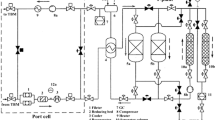Abstract
International Thermonuclear Experimental Reactor (ITER) is the first multinational fusion research facility, and test blanket module (TBM) is one of the most important components of ITER. The helium cooled ceramic breeder (HCCB) TBM and its auxiliary system are called HCCB test blanket system (TBS). Tritium extraction system (TES) plays an essential role in HCCB TBS. Potential risk of TES determines whether HCCB TBS can achieve tritium self-consistency and energy extraction. In this paper, potential risk analysis was performed on TES. By analyzing the potential failure modes of components, more than 60 basic failure events were obtained. The fault tree of TES failure is built. The qualitative analysis was performed on the tree model. Minimum cutsets (MCS) were obtained to identify the main impact factors of TES failure. Then quantitative evaluation was made based on MCSs, the mean failure rate of TES is 2.50e−3. The results showed the risk level of TES basically satisfied the operation requirements of ITER without regard of maintenance. The impact of basic events on TES failure probability is analyzed and ranked, the 10 high-impact basic events and corresponding components are obtained. The above mentioned analysis and results provide effective references for TES design optimization.





Similar content being viewed by others
References
R. Aymar, P. Barabaschi, Y. Shimomura, The ITER design. Plasma Phys. Control Fusion 44, 519–565 (2002)
J.N. Holtkamp, An overview of the ITER project. Fusion Eng. Des. 82, 427–434 (2007)
Y. Wu, F.D.S. Team, Conceptual design activities of FDS series fusion power plants in China. Fusion Eng. Des. 81(23–24), 2713–2718 (2006)
Y. Wu, F.D.S. Team, Conceptual design, testing strategy of a dual functional lithium lead test blanket module for ITER and EAST. Nucl. Fusion 47, 1533–1539 (2007)
L. Qiu, Y. Wu, B. Xiao, A low aspect ratio tokamak transmutation system. Nucl. Fusion 40, 629–633 (2000)
Y. Wu, F.D.S. Team, Conceptual design of the China fusion power plant FDS-II. Fusion Eng. Des. 83(10–12), 1683–1689 (2008)
Y. Wu, Q. Huang, Z. Zhu et al., R&D of dragon series lithium lead loops for material and blanket technology testing. Fusion Sci. Technol. 62, 272–275 (2012)
Q. Huang, C. Li, Y. Li et al., Progress in development of China low activation martensitic steel for fusion application. J. Nucl Mater. 367(370), 142–146 (2007)
Y. Wu, J. Qian, J. Yu, The fusion-driven hybrid system and its material selection. J. Nucl. Mater. 307–311, 1629–1636 (2002)
Y. Wu, J. Jiang, M. Wang et al., A fusion-driven subcritical system concept based on viable technologies. Nucl. Fusion 51, 103036 (2011)
L. Hu, R. Yuan, H.L. Chen et al., Failure modes and effects analysis on ITER DFLL-TBM system. Fusion Eng. Des. 87, 1307–1309 (2012)
D. Houtte, K. Okayama, F. Sagot, RAMI approach for ITER. Fusion Energy Des. 85, 1220–1224 (2010)
Y. Wu, F.D.S. Team, Development of reliability and probability safety assessment program RiskA. Ann. Nucl. Energy 83, 316–321 (2015)
Y. Wu, L. Hu, Y. Li, Development of third Qinshan nuclear power plant risk monitor. Chin. J. Nucl. Sci. Eng. 31, 69–85 (2011)
L.M. Leemis, Reliability Probabilistic Models and Statistical Methods (Prentice Hall, Inc., Englewood Clifs, 1995)
Acknowledgments
This work was supported by the National Special Program for ITER (Nos. 2014GB112001, 2014GB116000 and 2015GB116000), the Informatizational Special Projects of Chinese Academy of Sciences (No. XXH12504-1-09), and the Foundation of President of Hefei Institutes of Physical Science (No. YZJJ201327). The authors express appreciation and gratitude for the other members of FDS team. Thanks for their contributed to this work.
Author information
Authors and Affiliations
Corresponding author
Rights and permissions
About this article
Cite this article
Xu, J., Wang, D., Wang, J. et al. Preliminary Quantitative Evaluation of Potential Risk for HCCB TBS Tritium Extraction System Based on Fault Tree Analysis. J Fusion Energ 34, 1369–1377 (2015). https://doi.org/10.1007/s10894-015-9972-x
Published:
Issue Date:
DOI: https://doi.org/10.1007/s10894-015-9972-x




